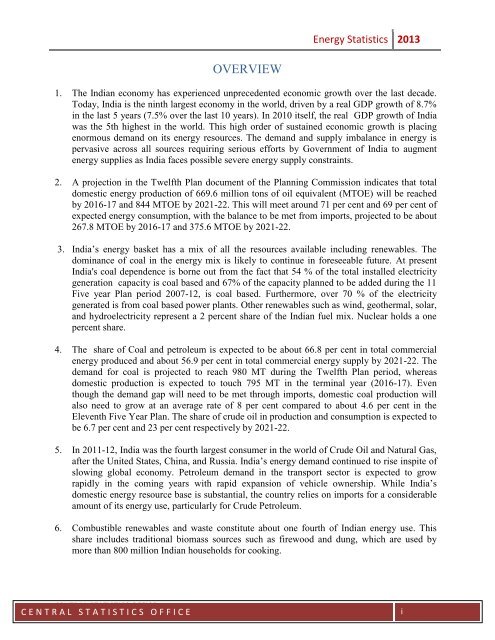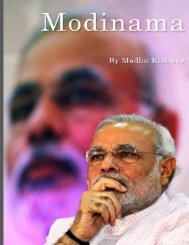Energy_Statistics_2013
Energy_Statistics_2013
Energy_Statistics_2013
You also want an ePaper? Increase the reach of your titles
YUMPU automatically turns print PDFs into web optimized ePapers that Google loves.
<strong>Energy</strong> <strong>Statistics</strong> <strong>2013</strong>OVERVIEW1. The Indian economy has experienced unprecedented economic growth over the last decade.Today, India is the ninth largest economy in the world, driven by a real GDP growth of 8.7%in the last 5 years (7.5% over the last 10 years). In 2010 itself, the real GDP growth of Indiawas the 5th highest in the world. This high order of sustained economic growth is placingenormous demand on its energy resources. The demand and supply imbalance in energy ispervasive across all sources requiring serious efforts by Government of India to augmentenergy supplies as India faces possible severe energy supply constraints.2. A projection in the Twelfth Plan document of the Planning Commission indicates that totaldomestic energy production of 669.6 million tons of oil equivalent (MTOE) will be reachedby 2016-17 and 844 MTOE by 2021-22. This will meet around 71 per cent and 69 per cent ofexpected energy consumption, with the balance to be met from imports, projected to be about267.8 MTOE by 2016-17 and 375.6 MTOE by 2021-22.3. India’s energy basket has a mix of all the resources available including renewables. Thedominance of coal in the energy mix is likely to continue in foreseeable future. At presentIndia's coal dependence is borne out from the fact that 54 % of the total installed electricitygeneration capacity is coal based and 67% of the capacity planned to be added during the 11Five year Plan period 2007-12, is coal based. Furthermore, over 70 % of the electricitygenerated is from coal based power plants. Other renewables such as wind, geothermal, solar,and hydroelectricity represent a 2 percent share of the Indian fuel mix. Nuclear holds a onepercent share.4. The share of Coal and petroleum is expected to be about 66.8 per cent in total commercialenergy produced and about 56.9 per cent in total commercial energy supply by 2021-22. Thedemand for coal is projected to reach 980 MT during the Twelfth Plan period, whereasdomestic production is expected to touch 795 MT in the terminal year (2016-17). Eventhough the demand gap will need to be met through imports, domestic coal production willalso need to grow at an average rate of 8 per cent compared to about 4.6 per cent in theEleventh Five Year Plan. The share of crude oil in production and consumption is expected tobe 6.7 per cent and 23 per cent respectively by 2021-22.5. In 2011-12, India was the fourth largest consumer in the world of Crude Oil and Natural Gas,after the United States, China, and Russia. India’s energy demand continued to rise inspite ofslowing global economy. Petroleum demand in the transport sector is expected to growrapidly in the coming years with rapid expansion of vehicle ownership. While India’sdomestic energy resource base is substantial, the country relies on imports for a considerableamount of its energy use, particularly for Crude Petroleum.6. Combustible renewables and waste constitute about one fourth of Indian energy use. Thisshare includes traditional biomass sources such as firewood and dung, which are used bymore than 800 million Indian households for cooking.CENTRAL STATISTICS OFFICEC E N T R A L S T A T I S T I C S O F F I C Ei



